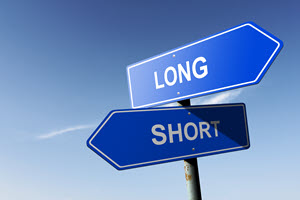Email Marketing: When in Doubt, the Answer is Seven
 When I was in high school our history teacher, Mr. Holt, shared his theory-of-life with us: when in doubt, the answer is seven.
When I was in high school our history teacher, Mr. Holt, shared his theory-of-life with us: when in doubt, the answer is seven.
A few weeks later we had a pop quiz in math, with an especially difficult problem at the end. At the one-minute warning, students who either hadn’t gotten to that question or who had and were unable to solve it, followed Mr. Holt’s advice: they wrote down seven as the answer.
Lo and behold, seven was the correct answer. But there was no way to get there by eyeballing it. The teacher was a bit surprised that so many people got it right, even without showing their work. When asked we confessed: it was Mr. Holt’s theory-of-life in action.
She then had a grade conundrum: do people who got it right because they were following Dr. Holt’s advice get the same credit as those who were able to show their work and come to the correct answer that way? What would you do? Hold that thought, more on that in a bit.
So how does this pertain to email marketing?
A lot of the email marketers I meet are looking for a silver-bullet theory-of-life like Mr. Holt’s. They ask vague questions in search of simple, silver-bullet answers. There are slew of common questions including:
- What’s the best day and time to send email?
- How many characters or words should my subject line have?
- Should my email message be long or short?
- How many efforts should I include in my email drip series?
- How many days should I leave between sends in my drip series?
Following Mr. Holt’s advice, we’d end up with:
 A seven-effort drip series, with each send seven days apart. Each email would consist of seven paragraphs, maybe each of those paragraphs would be comprised of seven sentences and each sentence would have seven words. The subject line would be seven characters or seven words, and we would send each message at 7:00 AM on Saturday, the seventh day of the week.
A seven-effort drip series, with each send seven days apart. Each email would consist of seven paragraphs, maybe each of those paragraphs would be comprised of seven sentences and each sentence would have seven words. The subject line would be seven characters or seven words, and we would send each message at 7:00 AM on Saturday, the seventh day of the week.
And this all might work just fine. Because, to steal from Joe Torre, email performance and sex are like pizza; when they’re good they’re really good and when they’re bad they’re still pretty good. Email is such a low-cost medium that it’s not difficult to show positive ROI; but by investing a little and going beyond silver-bullet thinking, you can earn much higher returns.
So, with apologies to Mr. Holt, here are my not-silver-bullet answers to those questions, along with the end note to the story of that math pop quiz.
What’s the best day and time to send email?
 There is no one answer to this question. And, in fact, if everyone has decided to send Saturdays at 7:00 AM, or any other single time, the best time to send would be any time but then.
There is no one answer to this question. And, in fact, if everyone has decided to send Saturdays at 7:00 AM, or any other single time, the best time to send would be any time but then.
Here I like to start with who the audience is – think about where they are at different times of day and when they might have the most time to consider your email missive.
In recent work for a consumer brand we saw higher open and click-through rates when we sent at 5:00 PM ET versus 9:00 AM ET on a weekday. And logically this makes sense: recipients were probably at work in the morning, just starting their day (or still on bed on the West Coast). Sending at 5:00 PM landed the email in their personal inbox after work hours, or in the afternoon on the West Coast, when they had more time to focus on personal business.
We saw a similar boost in performance when I was consulting for Hasbro. After months of sending during daytime hours, last minute changes to an email message forced us to send just after dinner on a Friday night – and generated the highest performance metrics we’d seen in a year or more.
How many characters or words should my subject line have?
 Seven characters or seven words is the Mr Holt silver-bullet answer here. But the truth is that you should include as many characters or words as you need to make a compelling case for the recipient to open your email message.
Seven characters or seven words is the Mr Holt silver-bullet answer here. But the truth is that you should include as many characters or words as you need to make a compelling case for the recipient to open your email message.
‘Meeting request’ has a few more characters than seven, but fewer than seven words. And it was an unbeatable subject line for one of my business-to-business clients looking to schedule product demonstrations with prospects.
But that isn’t to say that the best subject lines are always short. The length of your subject line plays a small role in its success or failure. What does impact performance is what the subject line says.
There is one quantitative rule of subject lines that I do adhere to with my clients: make sure that the key message of your subject line is conveyed in the first twenty-five characters. This is all you can guarantee people will see, because most email clients truncate subject lines.
Relying on this first 25 character rule allowed us to see an 14% boost in revenue for an e-commerce client when we tested: “20% Off Every Order – 12 Days of Christmas Day 9!“ versus the control: “12 Days of Christmas Day 9 – 20% Off Every Order!”
Should my email message be long or short?
 Once again, it’s about making the case to your readers, not how long or short your email message is. Instead of focusing on long or short, think of who your readers are and where they’ll be when they receive your email.
Once again, it’s about making the case to your readers, not how long or short your email message is. Instead of focusing on long or short, think of who your readers are and where they’ll be when they receive your email.
We generated a 170% lift in ROI for a B2B client by turning a very short flyer-type email into a longer letter-format message. We knew that the audience would be reading the email at their desks, so we felt like the longer format would engage them. It also allowed us to pull in data and industry quotes to outline the problem and describe how our product was the solution.
I’ve also got examples of long, meandering email messages which we’ve reimaged as shorter, easier to skim emails which generated large returns. There’s no one answer – it’s all about who your audience is and how much information you need to make the case for the action you want them to take.
How may efforts should I include in my email drip series?
 There is a simple answer to this – but it requires a little bit of thought. My formula for drip campaigns, and I create a lot of them for my clients, is to start with key topic areas you want to address and turn them into a message map.
There is a simple answer to this – but it requires a little bit of thought. My formula for drip campaigns, and I create a lot of them for my clients, is to start with key topic areas you want to address and turn them into a message map.
For instance, I was working with an industry organization on a drip campaign to turn free email subscribers into paid members. We discussed it and identified four key topic areas we needed to talk about to make our case:
- Networking/community
- Education
- Advocacy
- Cost of Membership
My formula for drip campaigns is to create one email message for each of the key areas and then bookend those with an introduction email that talks briefly about all four and a final email which reiterates key points about the four messages.
So, once you know how many key areas you have you just add 2 and that’s the number of efforts you need. In this case it was 6 efforts (4 key topic areas +2). In other cases, we’ve had more (6 key topic areas +2=8) or fewer (2 key topic areas+2=4). It all depends on how many key topic areas you need to cover.
How many days should I leave between sends in my drip series?
 Just like number of efforts, the cadence or send timing of each is simple to determine if you take a little time to think about your audience.
Just like number of efforts, the cadence or send timing of each is simple to determine if you take a little time to think about your audience.
Here the key information you need has to do with the journey. For instance, when I consulted for Verizon, we created a drip campaign to welcome new high-speed internet users. We wanted to quickly get them up to speed on all the features, benefits and advantages of their new service. There were seven efforts (because we had 5 key topic areas and 2 bookend emails, not because of Mr. Holt’s rule).
We knew there was a ‘honeymoon period’ during which new customers were excited about the service – so we decided to send these seven emails over the course of the first seven days of the customer getting the new service. We saw very good open and click rates and the series really helped these customers get the most out of their new service. Sending one a week or even just one every-other-day would not have had the same level of positive impact.
But a daily send isn’t the best idea for all drip campaigns. If it’s a longer sales cycle or if there’s action you anticipate the reader taking between efforts, you need to leave more time. The critical element to success is putting some thought into the cadence based on the audience, the journey and the content.
So how did students who followed Mr. Holt’s rule fare grade-wise on that math quiz?
 In the end, the teacher created a two-tier system for grading that question. People who had the correct answer of seven, but no notes or work that supported that answer, got half credit. If you showed that you worked the equation as taught and supported the correct answer with your work, you got full credit.
In the end, the teacher created a two-tier system for grading that question. People who had the correct answer of seven, but no notes or work that supported that answer, got half credit. If you showed that you worked the equation as taught and supported the correct answer with your work, you got full credit.
So, the moral of the story is: do the work. Even if you can earn half credit with a silver-bullet answer, the way to really make your email marketing effective and profitable is to do the work.
Give it a try with your email marketing program and let me know how it goes.

 How to resolve AdBlock issue?
How to resolve AdBlock issue? 